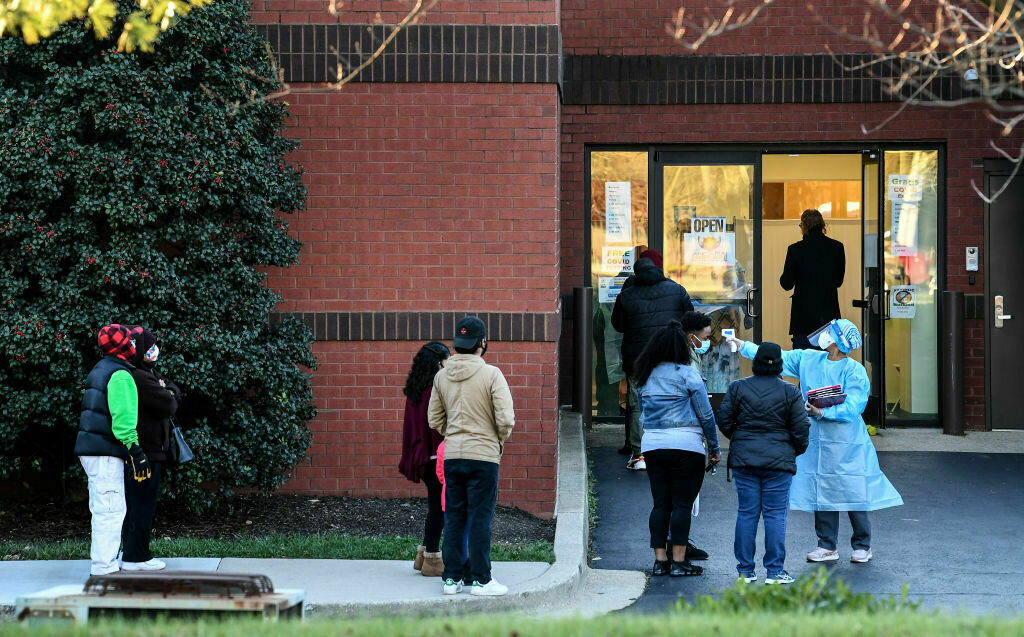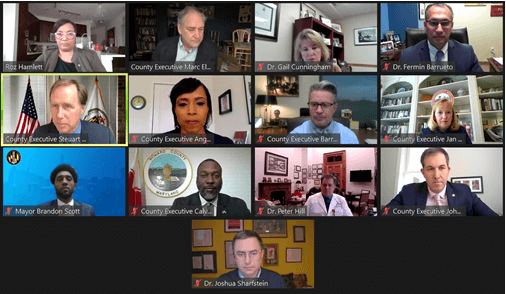
Montgomery County Executive Marc Elrich proposed new coronavirus restrictions Wednesday, including shutting down indoor dining and cutting capacity limits in retail shops in the populous Maryland county.
Elrich said the new restrictions were included in an executive order he sent to the Montgomery County Council on Wednesday. If approved, the restrictions would go into effect Tuesday, Dec. 15 at 5 p.m.
Under the proposal, indoor dining is temporarily paused, although outdoor dining, takeout and delivery could continue.
In addition, the order limits capacity at retail stores to one person per 200 feet and 150 total in a retail establishment, and also puts in place tightened capacity limits on sports and religious gatherings.
“We need a bridge to safety until vaccines arrive and are widely available,” Elrich said. “And until they’re widespread, the only control over the spread of this virus, our own behaviors … We saw what worked to reduce the cases in the beginning of the pandemic, and I believe we need to revisit some of those steps now.”
- Sign up for WTOP alerts
- Latest coronavirus test results in DC, Maryland and Virginia
- ‘The cavalry is coming’: Hogan details Maryland’s COVID-19 vaccine rollout
- Baltimore’s new mayor announces new COVID-19 restrictions
- Coronavirus vaccine FAQ: What you need to know
- Grim outlook for Maryland restaurant business in survey
Looking for more information? D.C., Maryland and Virginia are each releasing more data every day. Visit their official sites here: Virginia | Maryland | D.C.
Elrich, who has pushed Gov. Larry Hogan to take stronger action statewide, made the announcement during an online news briefing Wednesday afternoon in which the leaders of Maryland’s seven largest counties, along with Baltimore City’s new mayor, urged for consistent response to the COVID-19 pandemic across the state amid growing case numbers.

“We all believe that we’re facing a pivotal moment,” said Anne Arundel County Executive Steuart Pittman.
“Our state is in a dangerous place,” added Dr. Tom Inglesby, the director of the Center for Health Security of the Johns Hopkins Bloomberg School of Public Health.
He said that COVID-19 was the “No. 1 cause of death in America” in this last week, and that more than a third of Americans are living in areas running critically short of ICU beds.
Though the upcoming vaccination program is “the light at the end of the tunnel,” Inglesby said it will still take months before the general population can be vaccinated and for the vaccine to show an impact on the rate of spread of the coronavirus.
Inglesby urged Marylanders to continue to physically distance, wear face masks and avoid large gatherings. He also called on elected officials to temporarily close down settings that would likely speed up the spread of the virus.
“I think the fact that the COVID-19 vaccines are indeed likely the light at the end of the tunnel — I think what’s important is that we ensure that the tunnel doesn’t collapse before we get there,” added Dr. Peter Hill with the Johns Hopkins health system.
Hill said an increasing number of COVID-19 patients in Maryland’s health systems will impact non-COVID patients; he pointed to national data during the first surge in the spring, when non-COVID patients experienced delayed care because of the focus on COVID-19 patients.
He hopes that won’t happen now. “We want to avoid that as much as possible, and so our health systems are working very hard to do both at the same time, which is quite taxing,” Hill said.
Dr. Gail Cunningham, with the University of Maryland St. Joseph Medical Center, said the Baltimore County hospital has seen “a definite, significant increase” in the number of COVID-19 patients that it is treating, and that it has surpassed the spring numbers by 30 to 40%.
“We are very focused on our staff and trying to support them. They are stretched,” Cunningham said. Though hospital staff have put in extra shifts and are working hard, “it’s not going to be sustainable over the long haul,” she added.
“To assure that we can give excellent care to COVID and non-COVID patients, we need everybody throughout our state to own the responsibility of protecting each other, of wearing masks, of using hand hygiene, of social distancing, avoiding crowds, avoiding travel,” Cunningham said.
Elrich was the only local leader to announce new restrictions during the news briefing Wednesday.
Newly sworn-in Baltimore Mayor Brandon Scott announced tightened pandemic restrictions for the city on Wednesday ahead of the briefing, targeting indoor and outdoor dining, as well as capacity at religious facilities, retail establishments and malls.
Prince George’s County Executive Angela Alsobrooks said that contact tracing data shows the virus is spreading in households, not necessarily businesses, in the county.
“We’re finding that the primary superspreader has been family gatherings and friends getting together,” she said. “So, it’s a little more difficult to find a way to actually enforce those activities.”
All indoor gatherings in Prince George’s County, including in private residences, are already limited to 10 people.
Alsobrooks stressed the importance of remembering the humanity behind the health metrics.
“The numbers we’re talking about are actually people we love. We’re not talking about some distant statistic,” she said. “These are our colleagues, these are our family members, these are our friends, these are our neighbors. And so this has been for all of us a deeply personal sort of crisis.”
Pittman said he planned to announce further restrictions in Anne Arundel County on Thursday.
Regarding state vs. local action, Pittman said: “Yes, I and some of my peers, we’ve pushed the governor because the governor is the leader of the state. But that’s the way it’s supposed to work. That’s not a sign of disrespect.”
Frederick County Executive Jan Gardner said leaders working together across the area is key.
“We know the virus has no boundaries,” Gardner said. “So, what happens in our rural jurisdictions does affect what happens in our more suburban and urban jurisdictions. And so, the effectiveness of the decisions that we make individually are somewhat diminished by some of that inconsistency across jurisdictional boundaries, which is why regional statewide consistency is very, very important.”
During the briefing, the leaders expressed optimism about the coming coronavirus vaccines after Hogan offered more details on Maryland’s vaccination plan Tuesday.
Baltimore County Executive Johnny Olszewski said the vaccine is a reason to hope. “But people need to know we’re not there yet, and we haven’t yet realized that hope,” he added, warning of people becoming too complacent.
“We need those people to hear loud and clear, because this is no time to become complacent,” Olszewski said.
Also speaking at the news conference was Howard County Executive Calvin Ball and Harford County Executive Barry Glassman.
WTOP’s Jack Pointer and The Associated Press contributed to this report.









